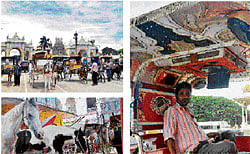How about a tonga ride this Dasara?

It was Mummadi Krishnarajendra Wodeyar who introduced sarot (chariot), for royal women and VIPs. Till then, pettige gaadi popular as aramane pettige gaadi, a box-type cart with a door on either sides or at the back, and pulled by bullocks was used by royal women in particular. It’s still one of the attractions during Jamboo Savari.
According to historian P V Nanjaraj Urs, who is also the author of Mysooru noorinnooru varshagala hinde, the credit of bringing horse-driven carts to Mysore goes to the royalty. Inspired, the common man, who till then was dependent on bullock carts, also began to utilise tonga, lesser in height with an open cabin for passengers and having two wheels.
The chariot, though, had a closed passengers’ cabin, four wheels and in some cases even six. In fact, it was during the reign of Hyder Ali and Tipu Sultan that chariots were introduced in Srirangapatna, which was later replicated in Mysore by the Wodeyars. It was also how the word shah pasand for these tongas came into being, adds Nanjaraj Urs. Rajachari of Kyatamaranahalli, who has been ekeing out a living as a tongawallah since 1967 recalls how the tonga was everyone’s favourite. All it cost from Agrahara Circle to Market was 10 paisa per person.
“There was a police inspector named Puttappa who had fixed the fare for every destination. From the railway station to the market, it was 75 paisa, to Gangotri (Manasagangotri the campus of University of Mysore) Rs 2.25. He would earned Rs 60 to Rs 70 at the close of the day, recalls Rajachari. He also recalls that princesses (daughters of last Maharaja of Mysore Jayachamaraja Wodeyar) were ferried by tonga to college.
Abdul Rehman of Ghousianagar has been a tongawallah for the past 35 years recalls that an annual licence fee was fixed at Rs three and it was in existence till 1977. According to Fayaz, President of the Shahpasand Tongawallahs’ Association, today there are 150 tongas in Mysore. Ambavilas Palace, St Philomena’s Church and the railway station are where they are all parked, for the convenience of tourists.
The Mysore City Corporation (MCC)’s initiative to revive the tradition has brought hope for tongawallahs. The Corporation introduced six chariots during Dasara last year under the heritage project of the Jawaharlal Nehru National Urban Renewal Mission (JnNURM). A chariot including the horse is priced between Rs two lakh and Rs 2.5 lakh. The kathewadi breed of horses alone are priced between Rs one and Rs 1.5 lakh.
A private agency which has mastered the art of chariot making from Patiala supplied the same and five more are ready to hit the streets. The Corporation has offered 50 per cent subsidy, apart from providing a bank loan. Suresh, one such beneficiary, explains, “I sometimes earn thousands per day. Hope this inspires other tongawallahs to opt for the chariot too. The MCC has planned to introduce 20 chariots. Stands have also been identified for these chariots, a spot near Ramaswamy Circle, KSRTC sub-urban bus stand among others. With nada habba set to be held from tomorrow till October 6, tongawallahs are hoping to cash in on the festive mood.
Deccan Herald is on WhatsApp Channels| Join now for Breaking News & Editor's Picks